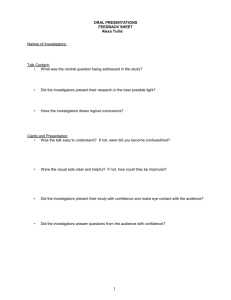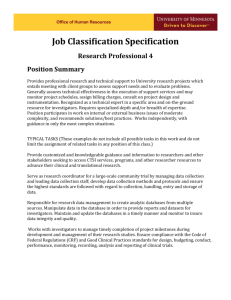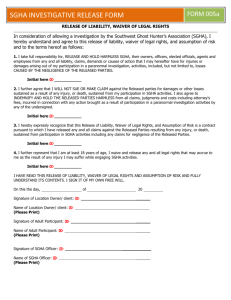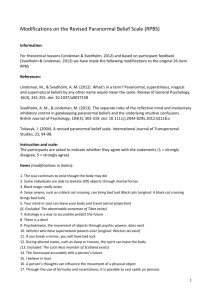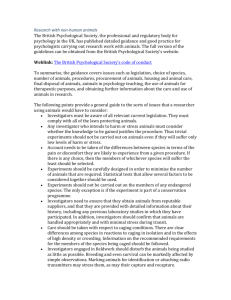2014 Paranormal Safety Pamphlet word file
advertisement
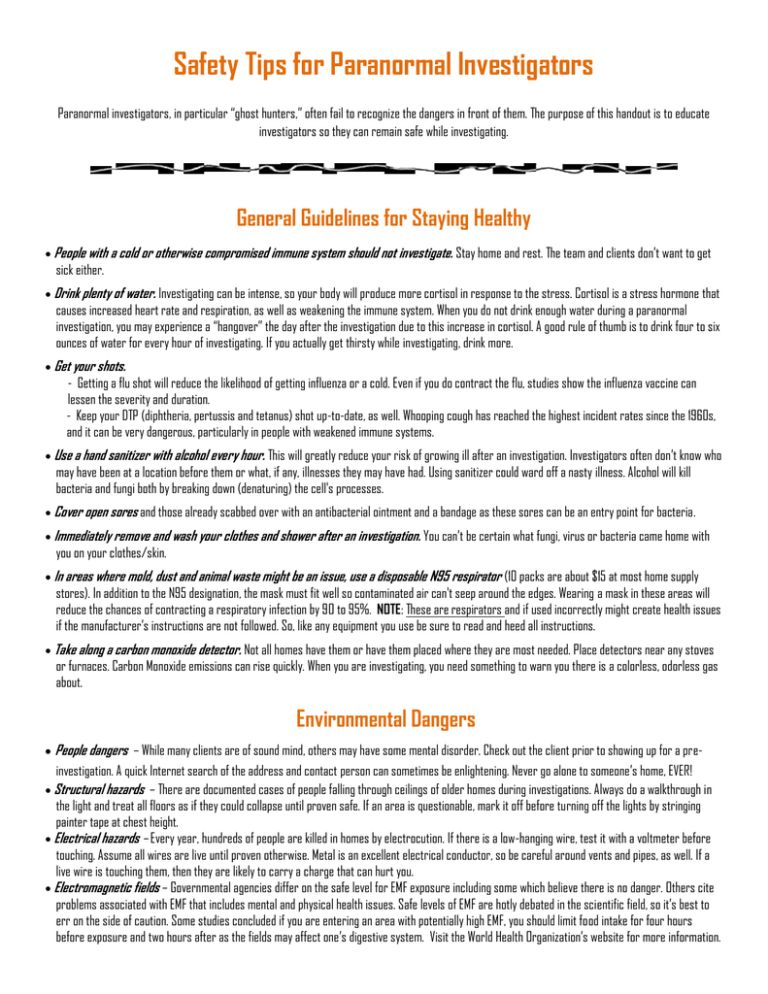
Safety Tips for Paranormal Investigators Paranormal investigators, in particular “ghost hunters,” often fail to recognize the dangers in front of them. The purpose of this handout is to educate investigators so they can remain safe while investigating. General Guidelines for Staying Healthy People with a cold or otherwise compromised immune system should not investigate. Stay home and rest. The team and clients don’t want to get sick either. Drink plenty of water. Investigating can be intense, so your body will produce more cortisol in response to the stress. Cortisol is a stress hormone that causes increased heart rate and respiration, as well as weakening the immune system. When you do not drink enough water during a paranormal investigation, you may experience a “hangover” the day after the investigation due to this increase in cortisol. A good rule of thumb is to drink four to six ounces of water for every hour of investigating. If you actually get thirsty while investigating, drink more. Get your shots. - Getting a flu shot will reduce the likelihood of getting influenza or a cold. Even if you do contract the flu, studies show the influenza vaccine can lessen the severity and duration. - Keep your DTP (diphtheria, pertussis and tetanus) shot up-to-date, as well. Whooping cough has reached the highest incident rates since the 1960s, and it can be very dangerous, particularly in people with weakened immune systems. Use a hand sanitizer with alcohol every hour. This will greatly reduce your risk of growing ill after an investigation. Investigators often don’t know who may have been at a location before them or what, if any, illnesses they may have had. Using sanitizer could ward off a nasty illness. Alcohol will kill bacteria and fungi both by breaking down (denaturing) the cell's processes. Cover open sores and those already scabbed over with an antibacterial ointment and a bandage as these sores can be an entry point for bacteria. Immediately remove and wash your clothes and shower after an investigation. You can’t be certain what fungi, virus or bacteria came home with you on your clothes/skin. In areas where mold, dust and animal waste might be an issue, use a disposable N95 respirator (10 packs are about $15 at most home supply stores). In addition to the N95 designation, the mask must fit well so contaminated air can't seep around the edges. Wearing a mask in these areas will reduce the chances of contracting a respiratory infection by 90 to 95%. NOTE: These are respirators and if used incorrectly might create health issues if the manufacturer’s instructions are not followed. So, like any equipment you use be sure to read and heed all instructions. Take along a carbon monoxide detector. Not all homes have them or have them placed where they are most needed. Place detectors near any stoves or furnaces. Carbon Monoxide emissions can rise quickly. When you are investigating, you need something to warn you there is a colorless, odorless gas about. Environmental Dangers People dangers – While many clients are of sound mind, others may have some mental disorder. Check out the client prior to showing up for a pre- investigation. A quick Internet search of the address and contact person can sometimes be enlightening. Never go alone to someone’s home, EVER! Structural hazards – There are documented cases of people falling through ceilings of older homes during investigations. Always do a walkthrough in the light and treat all floors as if they could collapse until proven safe. If an area is questionable, mark it off before turning off the lights by stringing painter tape at chest height. Electrical hazards – Every year, hundreds of people are killed in homes by electrocution. If there is a low-hanging wire, test it with a voltmeter before touching. Assume all wires are live until proven otherwise. Metal is an excellent electrical conductor, so be careful around vents and pipes, as well. If a live wire is touching them, then they are likely to carry a charge that can hurt you. Electromagnetic fields – Governmental agencies differ on the safe level for EMF exposure including some which believe there is no danger. Others cite problems associated with EMF that includes mental and physical health issues. Safe levels of EMF are hotly debated in the scientific field, so it’s best to err on the side of caution. Some studies concluded if you are entering an area with potentially high EMF, you should limit food intake for four hours before exposure and two hours after as the fields may affect one’s digestive system. Visit the World Health Organization’s website for more information. http://www.who.int/peh-emf/publications/risk_hand/en/index.html. Mold – You can find mold everywhere – both indoors and outside -- but it thrives mostly in damp environments. There are thousands of strains of mold, which are broken down into tens of thousands of sub classes. You can identify mold by its fuzzy appearance, which can be orange, green, black, brown, pink or purple. Most people do not experience any health effects from mold exposure. However, some molds can cause nasal stuffiness, eye irritation, throat irritation, coughing, wheezing to more serious lung infections. Mildew - There are two main types of mildew. Downy mildew starts as yellow spots, and then the color changes to brown. Powdery mildew is whitish in color and looks like talcum powder. Inhaling mildew can cause coughing, headache, scratchy throat and lung problems. Mildew can also start growing in lungs and cause other serious issues. Carbon monoxide - Often referred to as a silent killer, carbon monoxide is an odorless, colorless gas produced by cars and trucks, small gasoline engines, stoves, lanterns, burning charcoal and wood, gas ranges, and heating systems. Symptoms of carbon monoxide poisoning include headache, dizziness, weakness, nausea, vomiting, chest pain, and confusion. High levels of CO inhalation can cause loss of consciousness and death. Fiberglass insulation – Casual exposure to fiberglass is not a huge concern unless it is being moved or installed. However, in attics and under homes, you should wear a N95 disposable respirator where fiberglass insulation is present to avoid a potential lung infection. Asbestos – Investigating in areas with asbestos is dangerous if it not contained because exposure can cause serious lung damage and cancers. If asbestos is exposed, don’t investigate. Animal Dangers Birds and Bats in the United States carry over 35 diseases, 60 worldwide. Their droppings grow fungus that release into the air causing fungal infections. They also carry many bacteria and viruses. Snakes— Although many people are bitten on average, only five die from each year from snake bites because most seek out immediate medical care. The venomous snakes indigenous to the US are rattlesnakes, copperheads, cottonmouths/water moccasins, and coral snakes. Even non-venomous snakes can cause a reaction if the person bit is allergic to the snake’s bite. Spiders – There are over 3,500 types of spiders. Only two types have the potential to inflict a single fatal bite: Latrodecus (a.k.a. the widows; black, brown and red) and Loxosceles (brown recluse). The bites from the Tegenaria (hobo spider) are not typically fatal to humans, but substantial envenomation can cause prolonged systemic effects that can lead to death if untreated. All spiders are venomous; however, except for those listed above they generally only cause a mild irritation. Multiple bites from any spider, on the other hand, can cause a variety of health issues. Ticks bites are responsible for many contracting Lime-Disease from investigating cemeteries and other outdoor locations. Mosquitoes main diet is bird and bat waste so all the diseases they carry can be transferred by them. They also carry diseases from person to person. Bees—One does not need to be allergic to be seriously harmed or die from bee stings., disturbing a nest can spark a violent attack and multiple stings are dangerous. Fleas and lice carry various diseases whether or not cases of Epidemic Typhus and Rickettsia pox have risen in the last few years is highly debated. These both generally pass without medical intervention and often go undiagnosed. Epidemic Typhus often resembles the flu and Rickettsia pox a rash. Small Mammals including: Skunks, Mice, Chipmunks, Squirrels, Opossums, Raccoons, Armadillo, Beavers, Gophers, Prairie Dogs, and Rabbits carry a variety of diseases that can infect investigators by direct or indirect exposure. Below is a list of illnesses paranormal investigators have gotten after exposure to animals known to potentially cause them. Candidiasis Cryptococcosis Giardia Hanta Virus Histoplasmosis Leptospirosis Listeriosis Lymphocytic Chorio-meningitis (LCM) Rat bite Fever Salmonellosis St. Louis Encephalitis Tuberculosis Tularemia Anaplasmosis It cannot be proven the exposure actually was the cause of any illness. For more information on these illnesses visit the Center for Disease Control Website at: http://www.cdc.gov Health and Safety Equipment Every team should have a health and safety kit they carry with them on every investigation. CPR pocket mask – Hopefully you’ll never need to use this item, but in case someone needs CPR, several team members should be certified to administer it. Disposable N95 respirator masks – These are inexpensive but you should always wear them in areas where there is mold, heavy dust, or evidence of animal excrement. Emergency blanket – These little mylar blankets may not look like much, but if a team member is injured and goes into shock they are better than nothing. Polysporin antibiotic cream – Apply to simple wounds or put on existing sores and scabs before an investigation, as well as new ones that show up during the investigation. Bandages – Adhesive bandages (all sizes), adhesive tape, non-adhesive pads (Telfa), and 4" x 4" sterile gauze pads are essential for wound care. Anesthetic spray or lotion like Bactine or Calamine – Use these for rashes and insect bites. 2", 3", and 4" Ace bandages – Use these for sprains or strains, as well as for wrapping gauze on to wounds or securing splints. Benadryl – Use this oral antihistamine for allergic reactions and itchy rashes. Exam gloves - Use for infection protection. They can also be made into ice packs if filled with water and frozen. Safety pins (large and small) – You need these for splints and ace bandages. Scissors – Use these to cut tape and bandages. Tweezers – Use for splinter, stinger, or tick removal. Trash bags – These are good for a variety of things, such as making ice packs or covering a large would. Hand sanitizer – Use this often to protect against fungal, bacterial and viral infections. Carbon monoxide detector – Place these near furnaces and stoves to prevent accidental poisoning. Painter’s masking tape or caution tape – Use to mark off dangerous areas. Voltage tester—Use to test ALL exposed metal surfaces. This is quick and easy and could save a life. Bug Deterrent—To keep mosquitoes and ticks away. Medical Forms for each investigator— These forms should include a complete medical history. To protect a person’s privacy these forms can be kept in sealed envelopes with instructions on when the envelope may be opened and by who if the investigator is found in an altered state. Sample forms and envelopes can be found at paranormalsafety,com. - - - - Mental Health- - - Despite some skeptics believing all paranormal investigators are mentally ill, it is not the case. However, there are a small percentage of people who are mentally ill and seek refuge in the paranormal community. They may also contact teams to validate themselves. Some of these people may suffer from histrionic personality disorder (HPD), a group of mental illnesses where the individual needs to draw attention to him/herself. People with HPD often behave in overly emotional and dramatic ways to gain attention. Munchausen Syndrome falls into this classification of illness. Often people with these issues are only a danger to themselves. However, if a person with HPD doesn’t receive the attention he or she desires, he/she may engage in behaviors that put other investigators in danger in order to play the part of a hero to gain the craved attention. Team members may also become obsessed with the paranormal. This most often occurs with Intrusive Obsession Disorder. People with this affliction start dropping everything to pursue their addiction. Often, these people destroy family ties, lose jobs and friendships, suddenly show signs of reckless behavior, become reclusive, and may have changes in their personality. Much like an alcoholic or a drug addict, people with mental disorders need help to overcome their issues. This pamphlet was created by Elaine Davison, a paranormal investigator under the guidance of a physician using information provided by doctors, health departments and the Center for Disease Control. This does not cover every disease, infection or hazard investigators may encounter. It does provide some information on some of the most probable circumstances and tips to lessen the risk of illness and injury. *** This pamphlet is copyright free and may be reproduced. *** ParanormalSafety.com exists to promote safety awareness for all those in the paranormal field. Our goal is to provide safety pamphlets and share the stories of those who have been hurt or died so no other tragedies happen. We support the pamphlet distribution through book and safety kit sales. *** This pamphlet is copyright free and may be reproduced. ***
